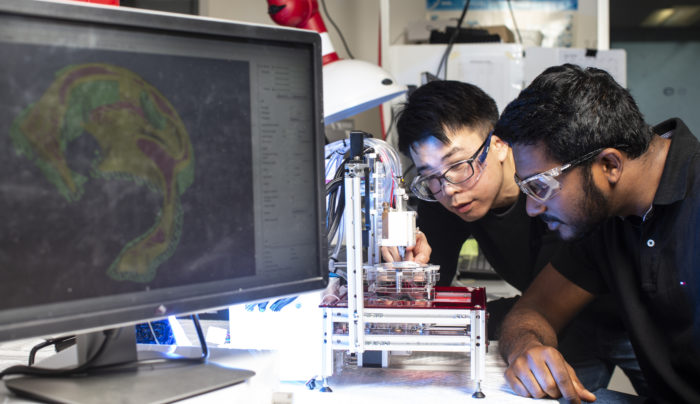News
3D printing bone tissue
Jun 28 2022
Royal Prince Alfred Hospital (RPA) in Sydney is now home to a world-first customised 3D bioprinter designed to create and make a 3D printed human ear, thanks to researchers from the ARC Centre of Excellence for Electromaterials Science (ACES).

RPA took possession of the printer this week in a key milestone for a joint research project between the ACES University of Wollongong node and Ear, Nose and Throat (ENT) Surgeon at RPA, Associate Professor Payal Mukherjee, to develop a clinical 3D bioprinting solution to treat microtia, a congenital deformity where the external ear is underdeveloped.
The ‘3D Alek’ printer is a customised multi-materials biofabrication 3D printer that utilises a specialised bioink developed and built by ACES researchers at the University of Wollongong and the Australian National Fabrication Facility (ANFF) to assist in the regeneration of cartilage for use in reconstructive ear surgery.
ACES Director Professor Gordon Wallace said the 3D Alek collaboration had benefited from drawing upon the diverse skills of a range of scientists, engineers and clinicians to bring about real advances to tackle this significant medical challenge.
“This project illustrates our ability to manage a successful pipeline to turn fundamental research into a strategic application to create a new health solution to improve people’s lives,” Prof Wallace said.
“We have been responsible for the primary sourcing of materials; the formulation of bioinks and the design and fabrication of a customised printer; the design of required optimal protocols for cell biology; through to the final clinical application.
“With one 3D Alek now established in a clinical environment at RPA and a replica in our lab at TRICEP, our new 3D bioprinting initiative, we will be able to fast-track the next stages of our research to deliver a practical solution to solve this clinical challenge.”
A/Prof Mukherjee said she was thrilled to be working with ACES researchers to develop a solution to combat microtia that is individualised to match the patient’s own anatomy.
“Treatment of this particular ear deformity is demanding because the outer ear is an extremely complex 3D shape, not only in length and breadth, but also in height and projection from the skull,” A/Prof Mukherjee said.
“This is where bioprinting is an extremely exciting avenue, as it allows an ear graft to be designed and customised to the patient’s own face using the patient’s own natural tissue, resulting in reduced operating time and improve cosmetic outcome, and avoids the current complication of requiring a donor site for cartilage, usually from the patient’s rib cage.”
The team will continue to advance research including undertaking initial clinical trials with a focus on accelerating the development of the specialised bioink by using stem cells from human tissue, with the hope of eventually being able to print a living ear using a patient’s own stem cells.













